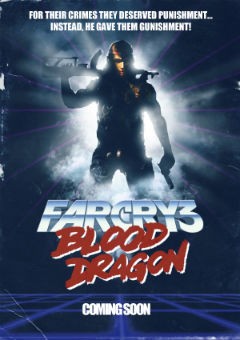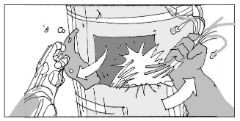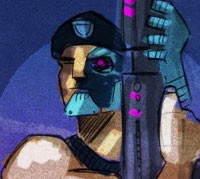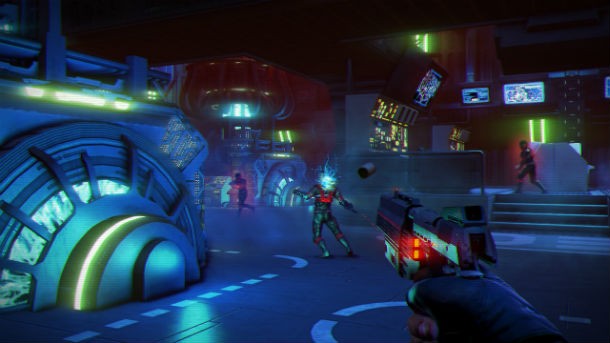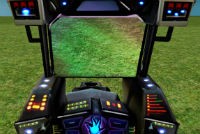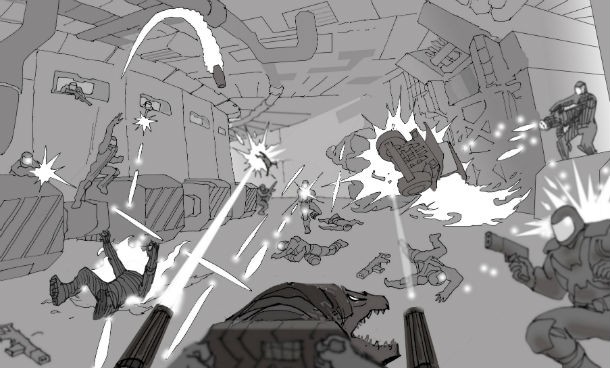Subscribe today to receive the next issue of Game Informer, featuring the Most Anticipated Games of 2026!
The ‘80s Strike Back: The Complete Story Behind Blood Dragon

Nostalgia is a valuable currency in the video game industry. Nintendo’s biggest titles stick to decades-old formulas, and the indie scene is overflowing with pixelated throwbacks. Earlier this year, Ubisoft took a different approach to the ‘80s homage with Far Cry 3: Blood Dragon. The standalone digital title combines the era’s iron-studded, fluorescent action films with Far Cry 3’s superb gameplay. Blood Dragon stands as an anomaly, both in terms of its aesthetic and marketing strategy. This is the story of how it all came together under the guidance of Ubisoft’s passionate 1980s savant, Dean Evans. It’s also the story of how Aliens: Colonial Marines nearly turned Michael Biehn, voice of Rex Colt, off from working in video games entirely, and how Hobo with a Shotgun director Jason Eisener helped inspire Ubisoft’s experiment.
A Stable Base for a Crazy Idea
Blood Dragon is a curious love letter to a bygone era built on a rock-solid foundation. Far Cry 3 hit late last year on 360, PS3, and PC. The latest entry in the multiplatform FPS sandbox series preserves the exotic setting: a tropical archipelago filled with animals and armed thugs. However, Far Cry 3 comes with some big changes to the series. Players gain new abilities by progressing through RPG-like skill trees. Far Cry 3 eschews the punishing realism of gun jams and malaria outbreaks with accessible, reliable gameplay more in line with modern, big-budget shooters. Enemy AI is improved, with patrolling pirates and indigenous wildlife that behave convincingly. Players can also liberate enemy encampments, creating a new safehouse and reducing the amount of roaming sentries. While the overall aesthetic of the game would change radically with Blood Dragon, all these elements (save for skill trees) remain. Critics praised Far Cry 3, and as of last May the game shipped 6 million units, 1.5 million more than projected.
|
The first piece of concept art for Blood Dragon |
Well before Ubisoft knew how successful Far Cry 3 would be, the company decided to take a new approach for the downloadable add-on strategy. Over the past few years, gamers have come to expect DLC in the form of new costumes, multiplayer maps, or a story-expanding campaign chapter. These iterative episodic additions usually only cater to people who completed the core game, alienating potential newcomers. In an effort to break out of this stale approach, Ubisoft took a chance with Assassin’s Creed III by crafting The Tyranny of King Washington, a standalone, alternate-history tale that deviates from the main game by pitting protagonist Connor against the preeminent founding father. For Far Cry 3’s add-on content, Ubisoft took it a step further with a standalone title that completely abandons the story, characters, and overall tone of the base game. The publisher opened up the doors to its development teams for ideas. Even the really crazy ones.
Among the Ubisoft Montreal devs organizing pitches for Far Cry 3 projects was Dean Evans. Growing up in the ‘80s, Evans spent his formative years binging on video games and absorbing the action section of his local video store in Surrey, a county in southeast England. He watched Arnold Schwarzenegger slaughter a police department over and over in The Terminator until his parents became concerned. Perhaps unbeknownst to his parents, Evans liked to pack up toy guns and practice breach and clear missions with friends at a nearby nursing home.
Bring up the topic of ‘80s action or horror films around Evans, and he responds with an enthusiastic stream of obscure film references, one-liners, or unusual game ideas exploring topics like animal revenge. Evans has an unbridled enthusiasm and a lack of self-censorship that’s rare in the PR-padded realm of the game industry. The powers that be at Ubisoft were smart, or crazy, enough to harness Evans’ overactive imagination to its advantage.
A screenshot from Far Cry 3: Blood Dragon's in-house pitch video
Evans funneled his penchant for hot pink hues and heavily armed heroes into an offbeat pitch for Far Cry 3’s downloadable counterpart. Set in a 1980s vision of the future, cyber commando Rex Colt sieges the island stronghold of his former military superior, Colonel Sloan. Far Cry 3’s modern pirates are swapped with leather-clad enemy cyborgs, giant laser-shooting reptiles roam the landscape, and the atmosphere is thick with moody fog and neon lights.
“Presenting it to some of the [Ubisoft] guys in Paris – those guys are brilliant poker players,” Evans says. “You’re doing the presentation to them and they’re faces are just like f---ing stone. It’s like, ‘Oh no! This is just going to be a f---ing disaster!’ Then once the presentation is, over they’re like, ‘Excellent. Good. Love it.’”
The editorial team greenlit the project, giving Evans’ team six months to complete it.

Far Cry 3: Blood Dragon creative director Dean Evans
From Wookiee, to Rookie, to Rockstar
Before Evans unleashed the ambitious insanity of Blood Dragon on Ubisoft, he made his entrance into the games industry with a Kashyyyk battle cry.
“It all started with a wookiee,” Evans says. “I was raging at a house party in South London and unleashed my throaty warble of a Chewbecca impression on an unsuspecting audience. Little did I know that a managing director of a fantastic advertising agency heard my wookie call and wanted to geek out. After a lengthy discussion, we got onto the topic of video games. His agency had just won the PlayStation direct marketing account and they were looking for an account executive. At this time, I was working as a delivery driver. Needless to say, I snapped up the opportunity to pursue a career in polluting minds. I always wanted to work in video games but at that time I had no idea how to get into it. The door was literally opened.”
A storyboard sketch of Spider's death at the hands of Colonel Sloan
After working on the PlayStation account, Evans joined Rockstar London as a product manager, helping launch titles like Max Payne 2, Manhunt, an#mce_temp_url#d Grand Theft Auto: San Andreas.
“These were truly my formative years in the industry,” Evans says. “Nobody understands tone and vibe quite like the folks at Rockstar Games, and working there opened my eyes up to what is possible in PR and marketing for video games. Break the mold. Shoot from the hip. Run with your gut feeling. We trusted each other’s tastes and sensibilities to create truly unique and artistic assets. If we like what we are doing and put gallons of passion into it, then this will be reflected in the final product and gamers’ attitudes.”
Rockstar’s dedication to consistent messaging, branding, and robust gameplay offerings would stick with him throughout his career. These lessons became invaluable when devising Blood Dragon’s effective marketing campaign.
|
|
Boasting games like Grand Theft Auto: San Andreas and Max Payne 2 in your portfolio speaks volumes, and in 2007 Ubisoft Montreal hired Evans as a marketing manager to help with gameplay trailers. He worked on the famous Assassin Creed “Lonely Soul” trailer, which pairs dramatic slow-motion gameplay of Altair with the somber vocals of The Verve’s Richard Ashcroft and driving beat of British band U.N.K.L.E. Evans’ careful music choices for trailers is an example of his passion for finding the right vibe for games.
After putting in his time as a marketing manager, Evans jumped over to game design with Splinter Cell: Conviction, where he helped develop Sam Fisher’s new customizable interrogations and Mark and Execute ability, which lets him rapidly gun down multiple enemies. Later he joined the conception team for Assassin’s Creed III, where he continued to flex his directing skills by putting together videos demonstrating design goals.
Assassin’s Creed III arrived in late 2013, shortly followed by Far Cry 3. Sometime before Far Cry 3’s release, executive producer Dan Hay told the team they had free reign on downloadable ideas for Far Cry 3. Hay wanted something unexpected, and Evans planned on seizing the opportunity to resurrect a VHS-era aesthetic he felt was lost to the times. Recent films like Manborg and Hobo with a Shotgun fueled his longstanding adoration of cheesy ‘80s action, and Evans felt this was the perfect time to tap the same vein of nostalgia with games. Manborg, released in 2011, is a low-budget science fiction adventure about vampire Nazis and cyborgs, overflowing with laser guns and green screen effects. According to Evans, Manborg “kicked him up the ass” to follow through on his vision.
Read on to learn about the axed armored minions of Blood Dragon and an important '80s sex scene

The Plague from Hobo with a Shotgun
Hobos, Armored Minions, and Aussie Synth
Hobo with a Shotgun led Evans down a rewarding rabbit hole. In a previous chat with Polygon, Evans revealed that he was particularly infatuated with The Plague from Hobo with a Shotgun. The Plague are a pair of iron-clad, otherworldly mercenaries that dish out mayhem with blades and a noose-tethered grappling gun. These demons were first conceptualized in director Jason Eisener’s school notebooks, fueled by the same ‘80s adoration afflicting Evans. The Plague’s dread-inducing synth theme especially hit a nerve with Evans. Throughout Blood Dragon’s development, Eisener would evolve from inspiration into an informal advisor.
|
A bomb Rex must dismantle |
“I can’t quite remember how he got a hold of my number, but [Evans] called me and we talked for a while,” Eisener says. “We kind of hit it off. We just had the exact same inspirations and tastes and things. At first I just thought it was kind of a joke. It took maybe five or six phone calls with him before I really believed that this was actually somebody from Ubisoft. It was just hilarious talking to someone who is so enthusiastic about the same things, and I just thought, ‘This doesn’t seem right.’ I had never heard of anyone from the video game world who talks like Dean. Then they actually flew me up last summer to Montreal to hang out with everyone at Ubisoft and kind of go over everything, give ideas, go through the script, and talk to everyone in different departments about it. “
At one point during their unofficial collaboration, Eisener and Evans were planning a boss battle between Blood Dragon’s Rex Colt and The Plague. Due to time restraints, the reference to Eisener’s monsters was reduced. In the final version of Blood Dragon’s “Summon the Plague” mission, Rex steps through a portal into a world of crumbling castle walls and purple lightning, imagery evocative of The Plague’s lair in Hobo with a Shotgun.
Eisener got Evans in touch with Power Glove, the Australian composers behind The Plague’s theme, and the developer eagerly reached out to see if they were interested. The soundtrack ended up being the first completed element of Blood Dragon. Under Evans’ leadership, the finalized collection of electronic drones, driving beats, and adrenaline-pumping melodies would become required listening for his development team.
A 360-degree peek at a 3D render of the evil Colonel Sloan
“I sent [Power Glove] a bunch of names of movies and soundtracks that I’m into,” Evans says. “I had a bit of a chat on the phone just to talk about pulses and drones. Man, honestly, in my time of working with composers and musicians, this was ridiculous. There were so many times on tracks that they sent over… no comments. We couldn’t give feedback on some of their first passes they sent back because they absolutely nailed it.”
Evans’ favorite track is “Omega Force,” which features a steady, John Carpenter-esque baseline, military drumrolls, and a slow, ominous build up. The group even remade The Plague’s theme from the film for the Hobo with a Shotgun-inspired Blood Dragon sequence.
“One of those glorious things about working with people who are into the same thing is they instantly click and get it,” Evans says. “You can talk about the tunnel scene in The Terminator and they’re like ‘Yup. Got it.’”
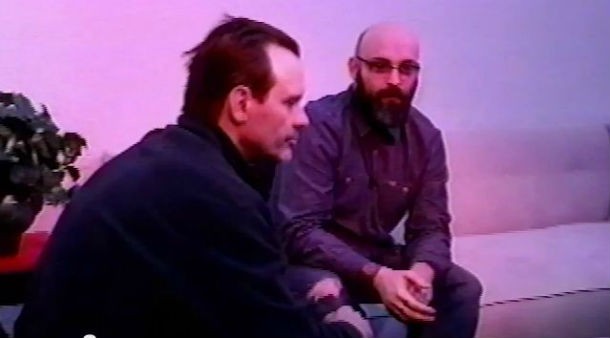
Michael Biehn (left) and Dean Evans (right) in a promotional video
Resurrecting a Hero
Speaking of The Terminator, Evans made another important connection with a star from the ‘80s film, Michael Biehn, during a day at the Fantasia Film Festival. Ubisoft was considering legends like Rocky IV’s Dolph Lundgren for the voice of reanimated cyborg solider Rex Colt, but an eccentric run-in with Biehn set fate in motion. Biehn, best known for battling Arnold Schwarzenegger as Kyle Reese in The Terminator and blasting xenomorphs as Corporal Hicks in Aliens, was holding a Q&A for his 2011 film The Victim.
“[Evans] didn’t ask a question as much as make a statement,” Biehn says. “He recalled that the first time he ever masturbated he was watching the sex scene in The Terminator. And then he said that he had recently masturbated to the sex scene in the movie that I had directed called The Victim. Everybody was I think a little stunned by it.”
After the brief, awkward exchange in front of the large crowd, Evans contacted Biehn’s wife, co-star, and business partner, Jennifer Blanc, to set up a meeting. He wanted Biehn to be the voice of Rex Colt. Blanc had to drag Biehn to meet Evans.
“The only other gaming experience that I had was I did a voice [Corporal Hicks] in the Aliens game that they made [Aliens: Colonial Marines],” Biehn says. “That wasn’t fun at all. I just didn’t really have any fun.
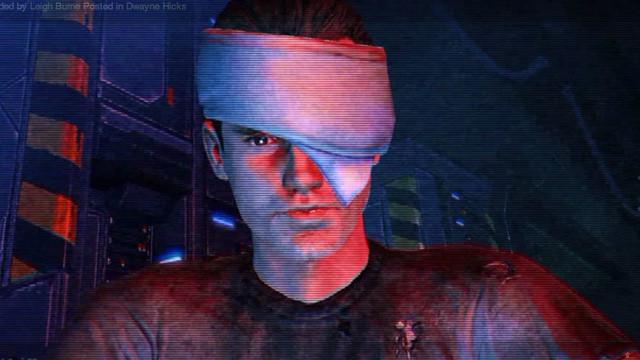
Michael Biehn's Corporal Hicks as he appears in Sega's Aliens: Colonial Marines
“It seemed kind of passionless. I think in movies, television, and the gaming world, you get some people that are really, really passionate, and some people that are just going through the paces. They think that because they have a brand name they’re going to get a hit game or hit movie out of it. That certainly was the situation on [Aliens: Colonial Marines].”
But Evans was different than Biehn’s past video game business partners. His affection for the era of Biehn’s heyday, knack for game development, and rapid-fire creativity drew him into the project.
“Dean is such an interesting and creative presence,” Biehn says. “He has such energy and such passion. One of the things that I really, really enjoy working still in this business is finding people that have that kind of passion.
“He was talking to me about the game and the fact that it was an ‘80s throwback, and there would be a lot of lines that were Arnold Schwarzenegger-like, that were [Sylvester] Stallone-like, Bruce Willis, myself. Those kind of lines, that kind of vibe, and the fact that it was going to be a throwback to the ‘80s was something that I thought was interesting. But really it was his passion, man. You just can’t say no to him.”
Biehn and Evans got to work recording Rex’s dialogue. Blood Dragon features a handful of slideshow-style cutscenes, complete with voice acting, but Biehn would mostly be delivering witty, satirical one-liners.
|
Concept art notes for Colonel Sloan |
“It was awesome,” says Eisener, who grew up adoring Biehn’s work and previously met the actor at another film festival [see sidebar]. “Dean was doing all his voice work with Michael in L.A. He was just texting me back and forth and we were throwing lines, and he was like, ‘What do you wanna hear Michael Biehn say? Like, if you could give him anything?’ Late at night I was just texting him all these crazy one-liners and then he would send me like video clips of him filming Michael Biehn saying the stuff that I’m sending him.”
Rex Colt single-handedly wipes out an island of dragons and robotically enhanced grunts in Blood Dragon. But it’s not his first rodeo, and you can hear it when he speaks.
“We wanted it not to be like my voice, not somebody that was somewhat fresh, somewhat interested in what he was doing,” Biehn says. “It was kind of like somebody that was old and done it 100 times. Done it 1,000 times. He was bored with it, bored with the whole situation, and angry. Cynical, really. We decided to go with a voice that sounded somewhat older than me.”
|
A close look at Colonel Sloan's cyborg enhancements |
The result is a haggard, gravelly voice that delivers glib, snarky quips throughout the game. Sometimes these cheesy quotes poke fun at video game tropes like collecting items. “Great, got another one. What the f--- am I doing?” Other times the lines sound like they could be straight out of Commando or another ‘80s action flick – “This little piggy went to the morgue.”
Biehn made his name in an era filled with Schwarzenegger and Stallone one-liners, but he traditionally played a more stoic underdog. Something the macho Rex Colt is anything but.
“I don’t think of [Rex Colt] as being completely different,” Biehn says when comparing Blood Dragon’s hero to his past roles. “I think that there’s an inner dialogue that goes on in my character’s head when I play those stoic [movie] characters. I just don’t talk. I don’t say the things that I normally would say. Like ‘This is bulls---,’ or ‘This mission is bulls---,’ ‘I hate this,’ ‘I hate that,’ ‘F--- you,’ and all that kind of stuff, you know? I think I was basically playing the same character but I say the inner thoughts that I’m not allowed to say on film.”
Locking down an ‘80s legend like Michael Biehn was a huge get for Evans. However, the team still faced the daunting technical challenge of revamping the Far Cry 3 engine to reflect the retro aesthetic.
| Another Unconventional Connection |
|
Similar to Michael Biehn’s odd introduction to creative director Dean Evans, the movie star also met the influential Hobo with a Shotgun director in a memorable way. Two years ago, Biehn’s film The Victim and Eisener’s Hobo with a Shotgun were being shown in a double-feature at the Sitges Film Festival in Spain. Eisener was giving a spirited talk to the audience about how the best way to experience his film involves disrobing. To Eisener’s surprise, the actor took it to heart. “Everyone’s cheering, and there’s a spotlight on me and I’m running down the aisle,” says Eisener. “And I just see this guy with his shirt off, with his arms, like, stuck out and I was like, ‘Who is that?’ I run up and it’s Michael Biehn! And so I rip my shirt off and we watch some movie with our shirts off together.” “[Eisener] made some comment about getting naked and watching his movie or something like that,” Biehn says, thinking back on the viewing. “So everybody laughed and jumped up and he got down from the podium and started walking up the aisle. And I got up and took off my shirt and unbuckled my belt and started to pull my pants down. By the time he got to me I was half naked and he saw me. I think it just kind of stunned him, you know. He started laughing. He took his shirt off and sat down next to me and we watched his movie.” |
Up next, building giant reptiles and creating Blood Dragon's retro brand
Evans advises the art team to take cues from campy '80s slasher Nail Gun Massacre
Unleashing Dragons and Crafting Thrift-Store Thugs
Far Cry 3 touches on survival, torture, and the very real violence of pirates in developing nations. The Blood Dragon team had to shift from these gritty themes to making a game about ripping out cyborg hearts and fighting dragons.
“The overall attitude, and I think I can pretty much speak for everyone on this project, was shock and awe in the most glorious fashion,” Evans says regarding the transition. “It’s not very often that you get to work on games like this, right? You look at a lot of big studios and there are not a lot of games of this tone and style. Everyone had a ton of fun.”
The team already had Power Glove’s soundtrack to set the mood, but Evans continued to force-feed the devs nostalgia. He shared ‘80s movie clips, blog links, and held weekly “Cyborg Nights,” where the team gathered to watch films like Robocop, Predator, and The Wraith. Blood Dragon is packed with references to such films.
|
The first conceptual poster for Blood Dragon |
In the latter movie, Charlie Sheen plays a dark specter that kills gang members with his turbocharged sports car. Sheen’s found-object outfit in The Wraith is a stylistic example of the bullet fodder roaming Blood Dragon’s island.
“The outfit that [Charlie Sheen] had – it’s so futuristic and he’s so alien, but it’s just black motorcycle leathers and a helmet with a few crappy cables wrapped around it,” Evans says. “That’s the kind of look and feel we wanted to go for. It kind of helps as well, from a modeling point of view, that we didn’t go absolutely too crazy on stuff and we tried to keep things so they can look like action figures. We’re using cheap objects and bolting them together like action figures. I think it paid off. The guys look pretty cool. It’s nice to say that one of your guys has a toaster as a face.”
The team saved time and resources by keeping the enemy design simple, but faced a larger challenge implementing the namesake blood dragons. Getting the tremendous, laser-shooting mutant komodos to gel with the environment proved difficult. The blood dragons are twice as big as everything else, which caused issues with how they interact with the game world. Ubisoft Montreal spent a lot of time combing over the entire island to make sure these imposing foes didn’t snag on geometry or cause other problems.
The dragons roam the island freely, sometimes obscured by an omnipresent fog. The mist creates a moody atmosphere while improving the large open world’s frame rate, but not without giving the team some trouble.
“The main problem we had from having fog was not being able to see enemies very clearly,” Evans says. “We tried a few different techniques, various different lighting setups on the enemies. But my art director and me were very adamant that the guys needed to be black. We really needed pinpoint light to distinguish them from everything. We were seeing what we could do with crazy lens flares and stuff, but again, we had six months. So all this stuff needs time to develop. But the tradeoff that we made was having the glow effect behind them. That’s like your classic hero shot. Like that front shot of Masters of the Universe, that shot of Dolph Lundgren on a poster where he has this big backlight with these huge rays behind him.”
Storyboard for an alternate ending to Blood Dragon
While the team found ways to make sure the dragons and fog worked, some ideas had to stay on the cutting room floor. Similar to the aforementioned scrapped boss fight with The Plague, players were originally destined to fight Colonel Sloan at the end of the game. Instead, Rex finishes off the power-drunk madman in a pixelated cutscene. In another scrapped conclusion, Rex eats Sloan’s heart, grows into a giant, and punches a Godzilla-sized Blood Dragon to death.
Ideas are commonly left on the cutting room floor throughout game development, but Evans blames the project’s lofty goals for some of those concessions.
“I think our biggest hurdle was our own fault, which was our own ambition,” Evans says. “We made all the wrong decisions throughout the whole process of this game. I’m not going to shy away from that at all. When you’re given the mandate to do an expansion or a DLC-type experience, you’ve got this [limited] amount of time; why the f--- would you choose to create new assets and a whole universe? It was just a really stupid thing to do. But whatever. You gotta roll the dice sometimes.”
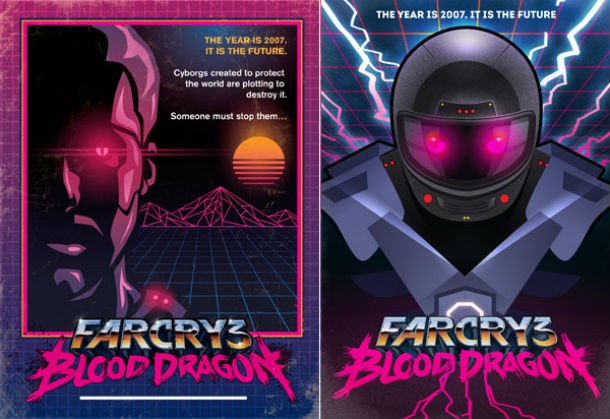
Early poster concepts from Signalnoise's James White
On The Campaign Trail
In the games industry, marketing plans are often planned and executed by in-house or third-party PR agents. But for Blood Dragon, Ubisoft granted Evans an uncommon amount of agency to spread the word. He learned the importance of powerful marketing at Rockstar, and he didn’t cut corners when it came to designing and orchestrating Blood Dragon’s marketing campaign.
Gamers got their first glimpse of Far Cry 3: Blood Dragon early last March via a listing on the Brazilian Classification Board. Lightning, vector grids, chrome letters, and hot pink paint splatters were the only clues gamers had to go on, but it was unmistakably ‘80s
The talented graphic artist behind Blood Dragon’s logo and posters is James White, who runs the independent studio Signalnoise. White has worked with companies like Toyota and Google, but spends much of his time designing alternative poster art for classic films like War Games and The Thing. Evans got in contact with White through Eisener.
“[White] lives in my hometown [Dartmouth, Nova Scotia],” Eisener says. “He actually lives just down the street. I always thought he was this amazing designer. In fact, I think it was 2007 when we made our first Hobo With a Shotgun fake trailer [for the Grindhouse trailer competition]. I got him to do the font and then I got him to do all the other fonts for all my other shorts and all my other movies.”
|
Sketch work for Blood Dragon's character poster |
White and Evans got in touch and immediately connected through their mutual adoration of the forgotten ‘80s style.
“Dean called me out of the blue one day,” White says. “He started talking my ear off about uzis, ninjas, and all that other stuff. So I was like, ‘Yeah, man, let’s do this.’
“I’ve been doing graphic design for 15 years now, and this was the project that I really felt most at home with. Dean and I share so many different loves of this VHS culture from the ‘80s that it was easy to start firing around ideas. It was very little guess work on my end, because I knew what Dean was looking for: a modern, unique take on that aesthetic from, like, ‘86 or ‘87. So the collaborative process was unlike anything I’ve ever worked on before because I wasn’t working for a committee of dudes sitting in board rooms. I was on the phone with Dean at 11 at night, yelling at each other about ninjas and robots and lighting and all that kind of stuff. I knew really, really early what he was going for and luckily that’s the kind of aesthetic that I’ve been living in for years now.”
The two worked through several logo and poster variations, hammering out concepts even before they knew Michael Biehn would be on board.
“I started with the two [poster] mock-ups,” White says. “One [protagonist] has a motorcycle helmet on. One has a laser eye with the sun in the background. Those two I made up really early on because we knew we wanted that second poster to be character-based – the second poster being the one with Michael Biehn on it. So, I start marking those up not knowing they got the likeness rights to Michel Biehn at this point. So I sent over those, and then Dean called me up and he said, in that thick British accent of his, ‘You’re not gonna believe this! We’ve got Michael Biehn.’ I just freaked out because, man, that’s Reese from Terminator and that’s Hicks from Aliens. I was just geeking out about it, so I dumped those two concepts right away and jumped right into painting the likeness of Michael Beihn, this guy whose movies I’ve watched my entire life. It was a big geek-out moment to know that we could use his likeness legally and get away with it.”
Up next, an April Fool's Day surprise and a bright future
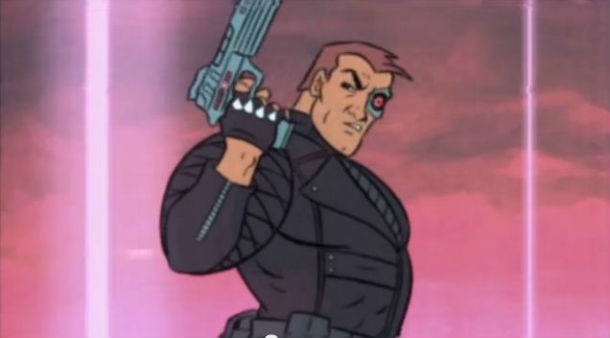
Rex Colt as a Saturday morning cartoon hero from a Blood Dragon trailer
A Fool’s Errand
Aside from creating stylish posters and working with clients, White also likes to create what-if April Fool’s Day products, like box art for a Calvin & Hobbes game. Unbeknownst to White, Evans shares a passion for April Fool’s gags and was planning something sneaky. On April 1, Ubisoft released the first official Far Cry 3: Blood Dragon teaser, which featured VHS-style tracking static, an animation of White’s logo, and a taste of Power Glove’s soundtrack.
“I sent off [the logo] and never thought anything of it,” White says. “And the day before April Fools’ Day, Dean texts me and says something like ‘Watch the internet.’ So I said, ‘Okay, cool.’ Then April Fools’ Day rolls around and that’s when the teaser video got launched with the animated logo and the lightning and the music. I was freaking out when I saw it because even the Ubisoft logo looked like an old-school VHS logo you’d see on those tapes that we’d rent. I almost started crying and stuff.”
“Honestly, I’ve always wanted to do this,” Evans says. “An announcement for something on April 1. It worked so beautifully with when we wanted to release.”
White loved the April Fool’s Day strategy. “I think Ubisoft declined comment for two weeks, so they let everybody online just stew and go crazy,” White says. “There’s nothing funnier than seeing gamers freak out on the Internet. It is so good.”
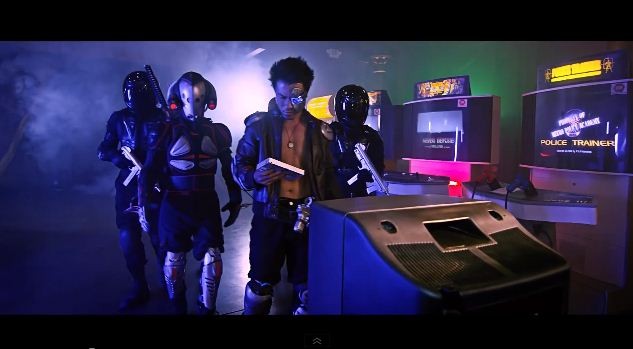
A screenshot from Corridor Digitals live-action promotion video, "Cyber War"
The public wasn’t sure if Blood Dragon was a farce or not, but it was slated for release exactly a month later. This left very little time to deliver trailers, gameplay walkthroughs, and execute other publicity. But it was all according to plan. Evans put his 10 years of brand and product management experience to good use, hitting gamers fast and hard in the short communication window.
“We were making sure to not show too much,” Evans says. “What was that quote? If you show them the bit of ankle, they’ll look for the robo-boobies.”
Unfortunately, not everything went according to plan. Reports of a leaked Blood Dragon build surfaced in early April.
“It was so scary when the game leaked,” Evans says. “The moment when the torrents were out, that was sheer and utter panic. We didn’t know what version of the game was leaked. And we were in production for six months. It could have been a version that went to the quality control team two months ago. Which, in video game late-development times, a game two months before it’s going to ship is a very, very different-looking beast.
“But the moment we realized that it was a final version of the game I felt good. It’s your baby. It’s left the nest, and it’s starting to walk and people aren’t calling your baby ugly. They’re saying ‘Oh your baby is cute!’ and they’re rubbing its cheeks and everything. Giving it a lick of ice cream.”
Good Vibes and Looking Beyond The Future of 2007
Some of those figurative licks of ice cream came in the form of positive review scores and over half a million downloads since the standalone game released for 360, PS3, and PC on May 1. Game Informer awarded Blood Dragon a score of 8.5, and many applauded Ubisoft’s unique downloadable approach. At the time some called the venture risky.
“Personally, I’ve never seen this as risky at all,” Evans says. “You’re guaranteed that there are going to be a lot of people who really like this aesthetic, so in a way it’s kind of no risk whatsoever. Or a calculated risk would be a better way of looking at it.
“Honestly, it’s not been that much of a fight or a rough ride throughout the whole thing. Ubisoft has been super cool throughout the whole process and has been extremely supportive, which is awesome. It’s nice to have that.”
Evans has support from more than just Ubisoft. The friends and business relationships that have formed through the creation of Blood Dragon have planted the seeds for future collaborations.
Development renders of Rex Colt's partner, Spider
“[Evans and I] became really good friends out of this,” Eisener says. “He came down for five days to Dartmouth and spent New Year’s with us. It was freezing cold here, so we just stayed in a basement playing video games for like five days straight. We were just constantly riffing off video game ideas and have constantly been talking ‘til now that we want to do something together and really punch something out. I can’t really say what it is we’re talking about yet. But we definitely have some really fun ideas of what we want to do together. I know though, we really want to do Doom. I want to make a Doom movie, and Dean wants to make a new Doom video game. We would love to just join those two forces together someday.”
The potency of Evans and Eisener’s combined ‘80s-infused creativity is not lost on Michael Biehn.
|
3D renders of the cockpit of Rex Colt's bad-ass blood dragon mount |
“I have a feeling I’ll hopefully be able to work with both of them in the future,” says Biehn. “I don’t know if the gaming world is a big enough world for Dean to tell you the truth. I wouldn’t be surprised if Dean moved off into movie-making and that type of thing.”
Biehn is quick to compliment Evans’ roiling creativity, having compared him to legendary filmmakers like Quentin Tarantino and James Cameron.
“I must admit I did pull that one out at the pub yesterday in a nice, pedantic, sarcastic British way,” Evans says. “‘Oh, hang on. I just got a text here, it’s nothing. Oh! It’s just Michael comparing me to Quentin Tarantino. That’s all. Yeah, that’s cool, man. That’s cool. Whatever.’ I’m not Quentin Tarantino, that’s for sure.”
“But I am James Cameron,” he says with earnest.
Concept art demonstrating Rex Colt's dramatic siege of Sloan's base
As for the future of Blood Dragon, fans would be happy to see a sequel. In interviews with Biehn, the actor has mentioned a successor might be in the works. Evans is quick to put the actor’s enthusiasm into perspective.
“I’ve also told [Michael Biehn] about how I want to purchase the Robocop license at some time,” Evans says. “I’ve spoken to him about a number of different things. There’s a lot of things I’d really like to do. In terms of the product catalogue at Ubisoft, a sequel is not in discussion at all. Obviously I would love to do something and continue things, but it’s not my decision whatsoever.”
Ubisoft may not have immediate plans to continue Rex Colt’s cybernetic adventures, but the future is bright for both Dean Evans and the company’s downloadable strategy. Blood Dragon’s success sets a good precedent that companies can make bold, exciting moves with established IPs that depart from serial storylines.
“I think a good way to look at it is if we look at triple-A titles and the way we see Far Cry 3: Blood Dragon, almost look at it like an EP,” Evans says. “Where you’ve got the radio-friendly A-side, nice friendly one, and Blood Dragon is that B-side. That kind of experimental one that’s like eight minutes long and a bit abstract and a bit strange. But it’s also a really memorable track. A memorable song. I would really like to see more studios try out this technique because it’s really fun and it’s really liberating.”
Ubisoft is planning a Far Cry 4 announcement soon, and we hope Evans tunes the band for another eccentric B-side.
Enjoy Power Glove's Blood Dragon soundtrack? Check out some similar musicians

Get the Game Informer Print Edition!
Explore your favorite games in premium print format, delivered to your door.
- 10 issues per year
- Only $4.80 per issue
- Full digital magazine archive access
- Since 1991
